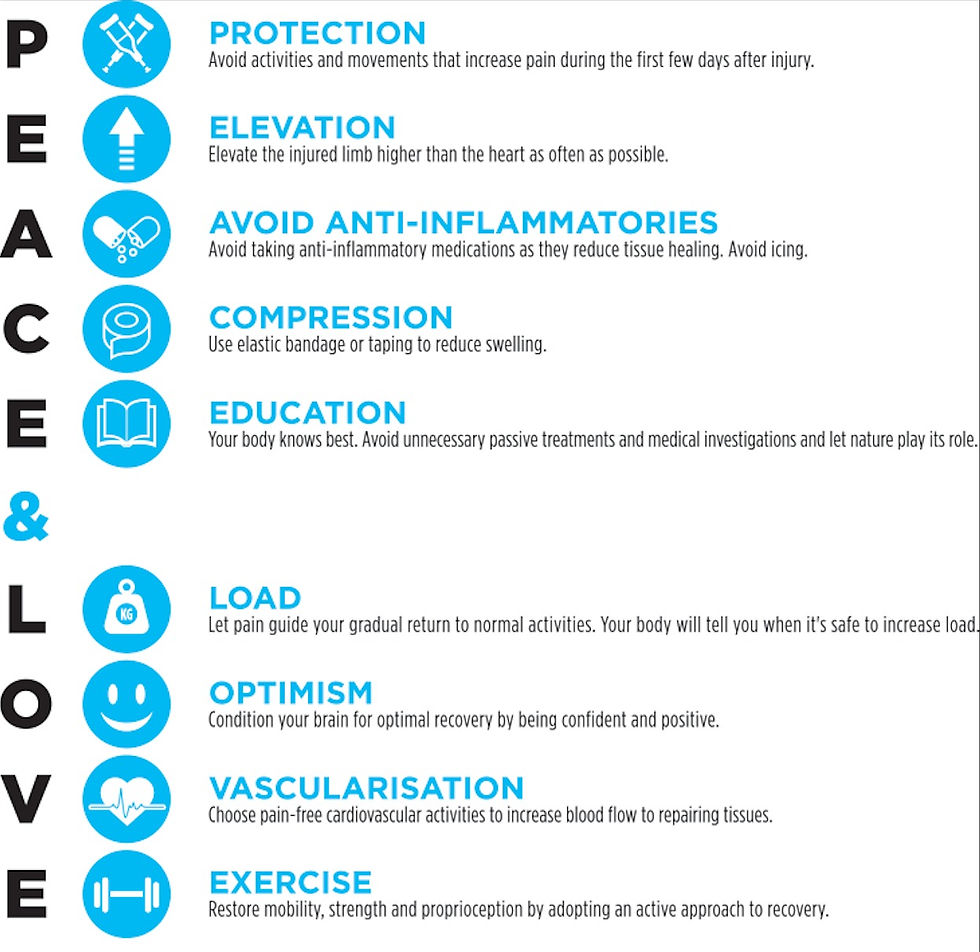9 Things to do for an Acute Athletic Injury...PEACE & LOVE Instead of RICE!
- Kassi Schuppe
- Aug 5, 2020
- 3 min read

Have you ever sprained your ankle, twisted your knee, or jammed a finger? What was the first thing you were told to do after? Ok...after you were told to get up and dust it off 😂 I think it is safe to assume that you were told to put ice on it or follow the RICE principle: Rest, Ice, Compression, and Elevation. While compression and elevation are still recommended following an acute athletic injury to assist with swelling management, rest and ice actually work against the healing process. Let's take a deeper dive into learning more about the healing process to understand why ice and rest are detrimental to healing and what you should do instead!
The Healing Process

The first stage of healing is the inflammatory phase. In this phase, inflammation occurs and activates the healing process. This increase in blood flow brings nutrients and healing factors to the injured area to help heal the damaged tissue. Cells called neutrophils destroy bacteria (in an open wound) and macrophages come in to remove the damaged tissue from the trauma. These cells also release insulin-like growth factor (IGF-1), which sparks the next phase of the process, proliferation, where muscle repair and regeneration begins.
Without inflammation, the progression of the healing process is stunted. Placing ice on an injury sets up a road block for the white blood cells that are trying to get to the injured area to kick start the healing process. If the white blood cells are not able to get to the area quickly to clean up the damaged tissue and stimulate IGF-1, it will not only slow down phase 1 of healing, but also delay the start of phase 2. So ultimately, inflammation is necessary for the healing process to work correctly.
Now you may be saying, well isn't inflammation bad because it can cause negative effects. Yes, excessive and long-term inflammation can lead to an increase in pain, loss of range of motion, and increased recovery time. It is definitely important to manage swelling after an injury to help speed up the overall recovery process, but the way in which we manage the swelling is the key. It is first important to understand what happens after the initial inflammatory response and how our body processes the swelling in order to understand the best way to manage it.
With the initial inflammatory process following an injury, white blood cells and the healing factors are brought to the injury site via our circulatory system. This rush of blood flow to the area also draws additional fluid into the surrounding area, what we typically call swelling. This swelling contains waste byproducts from the neutrophils and macrophages that cleaned up the damaged tissue. However, this swelling must find its way back to the heart for our body to then deliver the waste byproducts to the appropriate ares to be filtered. The swelling's path back to the heart is through the lymphatic system.
The lymphatic system contains a series of passive vessels, meaning that in order for the swelling to move through the vessels, an active action has to take place to push the swelling along the path. This active action is called muscle pumping. The repeated contraction of the muscles around the vessels is the driving force behind moving the swelling through the lymphatic system, so without movement, the swelling can remain in the area and lead the negative effects mentioned before. So while rest and ice may be your initial thought following an acute athletic injury, ice and rest will both delay the healing process.
Use PEACE & LOVE* Following an Acute Athletic Injury Instead of RICE!

* Disclaimer: if you have suffered a significant athletic injury, it is recommended that you have that injury evaluated by qualified professional for proper medical management.
PEACE & LOVE takes an active approach to the recovery process and in the long run, early movement and intervention is the key to a quick recovery! I would even argue that exercise (or at least movement) should be the first "E". Gentle movement of the affected area should begin immediately following the injury. This will not only help facilitate the healing process and increase muscle pump to manage swelling, but it also keeps the nerves and muscles firing and communicating which ultimately helps them recovery faster.
If you have suffered a recent athletic injury and would like some further advice about how you should specifically handle your recovery or how you can safely continue to exercise and progress back into your normal workout routine, give us a call at 515-985-9038 or send an email to kassi@enhanceptdsm.com.

Comments